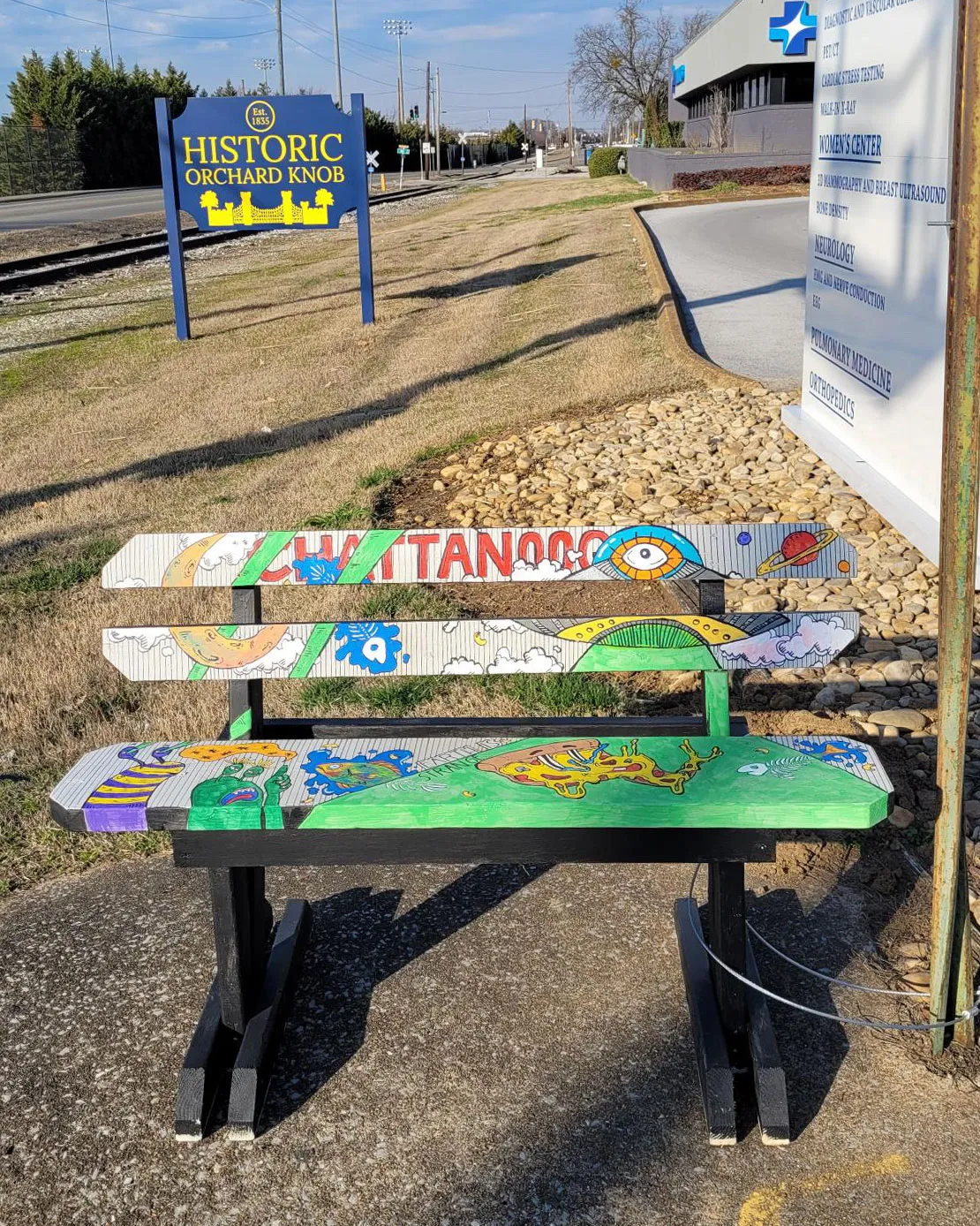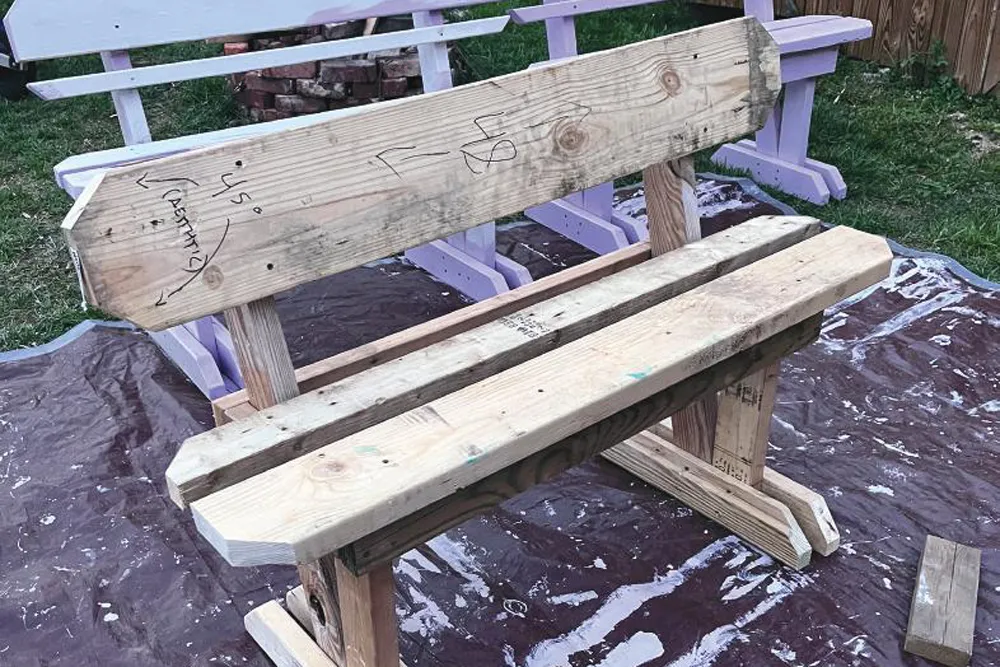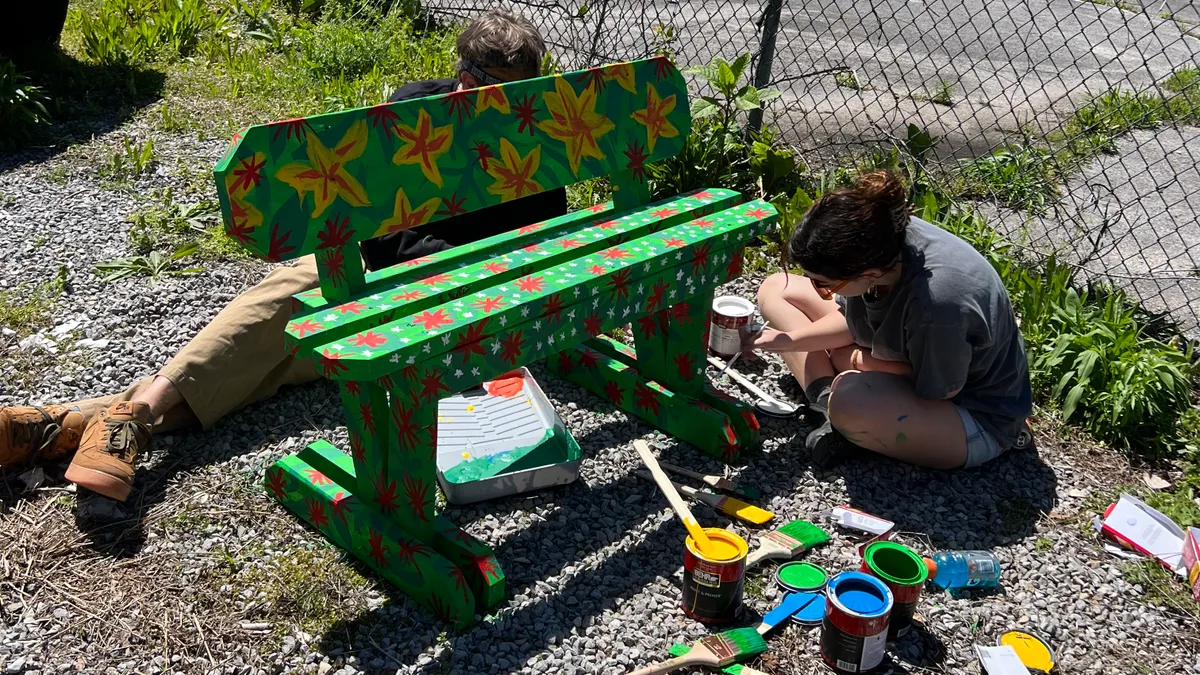A person leans against a guardrail next to a busy road while waiting for a bus in Chattanooga, Tennessee, in a video posted to TikTok in March 2023.
The video shows one of about 1,200 bus stops serving more than 80,000 riders across the city. Fewer than 5% — just 56 stops — have benches provided by the public transit authority, said Jon Jon Wesolowski, founding member of the Chattanooga Urbanist Society, the grassroots group that posted the TikTok.
The video goes on to show a society member building a bench out of wooden planks behind the guardrail and away from traffic. On the seat, the group wrote a message to bus riders: “The city should have built you a bench. Sit if you agree!”
Chattanooga Urbanist Society is among the groups around the U.S. and the world that engage in what some call “guerrilla urbanism”: They develop low-cost, short-term interventions to serve community members and inspire long-term change. Whether they are installing bike lanes, planting gardens in vacant lots or painting crosswalks, guerrilla urbanists usually do not ask for government permission. As the Chattanooga society says on its website, its members are “doing it our damn selves.”

Some guerrilla urbanists attribute their actions to local governments failing to provide and maintain infrastructure in a timely manner.
“If something has happened in a city [that’s] strong enough to unite a group and make them publicly work towards a unified end together, something must be really wrong with that city,” Wesolowski said. For example, often “[car] traffic throughput is prioritized over safety, over local businesses, over the people who live in that area. So if it's bubbled up to the point where people are taking action, we should start to see this as a red flag.”
Governments that disapprove of guerrilla urbanism projects — which could be illegal — counter them with actions that range from removing citizen-built infrastructure to sending police. But guerrilla urbanists and experts interviewed for this story say that rather than fighting back, governments should take the opportunity to learn what concerns lie behind these groups’ actions.
The power of people to do things themselves
Jeffrey Hou, head of the architecture department at the National University of Singapore, said governments and urban planners that once brushed aside guerrilla urbanism now have a growing understanding of its role in filling gaps left by institutions.
Urban planning decisions are generally made by city officials or professionals, said Hou, who has researched guerrilla urbanism in the U.S. and East Asia. “There is still low recognition for the ability of people to do things on their own.”
Chattanooga Urbanist Society, founded in 2022, focuses on making the city more pedestrian-friendly by building benches. So far, Wesolowski said it has placed more than 60 benches around Chattanooga. The group accepts service requests from the public, whether it’s for installing a bench in a certain spot or clearing a tree-blocked sidewalk after a storm. CUS also wants to begin painting crosswalks at intersections in Chattanooga, few of which have markings already, Wesolowski said.

The city government has largely reacted positively to the group’s work, he said. It hasn’t fined the group or removed any benches. Wesolowski said the mayor even attended CUS Earth Day trash pickup on April 22. But when the group has installed signs marking spots where pedestrian-involved crashes have occurred, the city has taken them down, he said.
A guerrilla urbanist group in Los Angeles has experienced a less favorable government response.
Crosswalk Collective LA paints its own crosswalks around the notoriously car-centric city. The group formed in 2022, after the city of LA disabled an online form for taking infrastructure requests.
“How else are we supposed to draw the attention of the people that are supposed to be installing this infrastructure other than to put it in ourselves?” said a member of Crosswalk Collective who requested to remain anonymous to avoid government retaliation.
Crosswalk Collective LA has received hundreds of requests from the public for crosswalks at specific intersections, this member said. “If the city were to do its job [that] we as taxpayers pay for them to do … then there would be no reason for our group to exist,” the member said.
The Los Angeles city government has often been hostile toward Crosswalk Collective, the member said. The city rarely notices the group’s crosswalks, but when it does, it paints over them.
The LA Department of Transportation declined an interview with Smart Cities Dive, but in an emailed statement said that “LADOT shares the community’s urgency to make our streets safer. Working with individuals and community groups, LADOT installs and improves thousands of critical safety treatments every year. Crosswalks can only be installed by LADOT or a contractor assigned by the department in order to meet standards set by the Manual of Uniform Traffic Control Devices for California.”
But the city’s work to date has not satisfied residents. Voters passed a ballot measure in March that forces the city to carry out its nearly decade-old mobility plan, which has largely gone unimplemented. Of the 3,137 miles slated for bike, bus and pedestrian upgrades in the plan, the city had only modified 3% as of 2022, according to the Los Angeles Times.
‘The real issues’ behind guerrilla urbanism
Guerrilla urbanism makes people realize that they can fix problems and modify public spaces themselves, sometimes quicker than government can, Hou said.
Ideally, the government holds a public meeting to discuss proposed changes to a street and considers all needs, said Conrad Kickert, associate professor of architecture at the University of Buffalo. If people can change public spaces at will, they run the risk of circumventing democratic process, raising questions about who is in charge of public space, Kickert said.
There’s also a question of whether guerrilla urbanism is an effective way to address systemic problems, he said.
“If we think about rising sea levels, or we think about urban heat island [effects and] climate change, or we think about housing affordability, is that solvable at the guerrilla level?” Kickert said.
Wesolowski said guerrilla urbanism makes participants more aware of their community and the built environment.
“City employees and public servants should see guerrilla urbanism and get excited by it because what you're finding is solutions-oriented people who are activated to serve their community,” he said. “You have these people who are not necessarily asking for permission, but they're showing a willingness to get involved.”
Local governments can accomplish more by working with guerrilla urbanists rather than fighting them, Wesolowski said. CUS has found a willing government partner for some of its efforts: It will be collaborating with the Hamilton County Regional Planning Agency to create a buffer of flower boxes between bike and car lanes on a street in the county, which surrounds Chattanooga, he said. But CUS has to find private funding for the project.
The Crosswalk Collective member defended the group’s guerrilla urbanism efforts in Los Angeles, saying they have allowed people to cross streets with an increased sense of safety. Governments need to work on administering services more efficiently because in the meantime, pedestrians suffer, the member said. The number of people killed by cars in Los Angeles was 81% higher in 2023 than in 2015.
“[Governments] are doing something really harmful to the people that they supposedly claim to be serving,” the member said.
The speed at which LA has painted over the group’s crosswalks shows it can act quickly, the member said. “They can go in and remove a crosswalk in a week, but they can take years to install one,” the member said.
Guerrilla urbanism and government urbanism each has its place, Kickert said. Governments need to build structures like train lines or sea barriers while also allowing spaces to be flexible enough that people can make them their own, he said.
Sometimes, projects enacted by guerrilla urbanists can become part of official policy. That’s what happened in Detroit with urban gardening, Kickert said. As the city experienced an estimated 30% property vacancy rate, as well as high food insecurity levels, residents started “guerrilla gardens” on vacant land. Some gardeners began organizing to advocate for urban farming and food policy; one such grassroots leader, Tepfirah Rushdan, was the city’s first director of urban agriculture and is now director of Detroit’s Office of Sustainability.
Hou said more communities have legalized street vending, another form of guerrilla urbanism. And pedestrian-only streets, which used to be anti-establishment, are now commonplace around the world, he said.
Governments can take guerrilla urbanism activity as an opportunity to engage the local community and get residents involved in fixing issues, Hou said. He added that governments could even fund community members willing to do the work themselves.
It’s a chance for governments to see what people need and what service gaps exist, he said. “Rather than just brushing them aside as illegal, informal quick fixes, [look] at it more from the perspective of the community,” Hou said. “What are the real issues behind those interventions?”
Clarification: This story was updated to more clearly represent Hou’s perspective on who typically makes urban planning decisions.



















